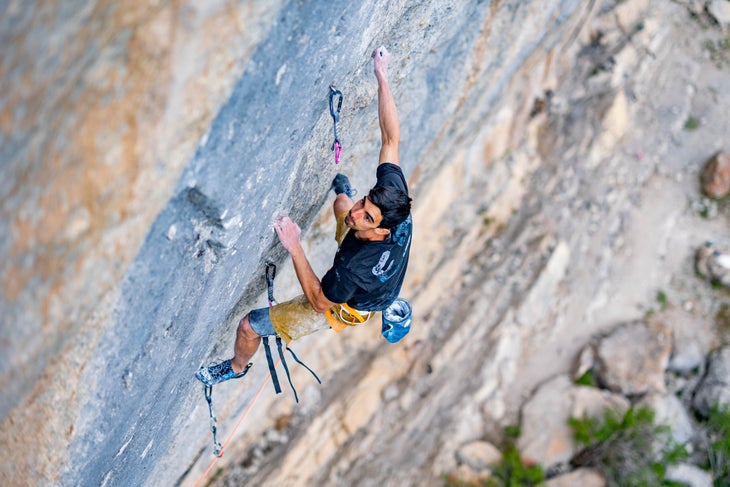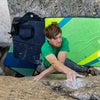Heading out the door? Read this article on the new Outside+ app available now on iOS devices for members! Download the app.
On October 16, Jorge Díaz-Rullo, 24, finished off his multi-season battle with Bibliographie (5.15c) in Céüse, France. Bolted by Ethan Pringle in 2009 and first climbed by Alex Megos in 2020, Bibliographie has also seen repeats by Stefano Ghisolfi, Sean Bailey, and Seb Bouin.
Díaz-Rullo has previously climbed nine 5.15b’s—including classics like First Round First Minute, El Bon Combat, and La Planta de Shiva—and one 5.15c, Mejorando la samfaina, which he established in Margalef earlier this year.
Bibliographie took him roughly 60 days of effort spread over three years and multiple visits to France.
Díaz-Rullo first tried Bibliographie in the summer of 2021, when Stefano Ghisolfi and Sean Bailey were still working on it, and though he could do all the moves, he found the crux sequence too hard to link. So he stepped away to train max power. Returning the next year, he found himself able to link the crux boulder, but he “still didn’t feel completely ready,” he said on instagram. “I was lacking a bit physically, and mentally I had a lot to improve.” When he returned this past May, the boulder felt far easier, but conditions weren’t aligning. After a few good attempts between rainy spells, he again stepped away to train. “I had never trained so much,” he wrote. “Thanks to that, I was more confident than ever that I had the physical level to do it.”
Having seen both Seb Bouin and Sean Bailey fall high on the route, after the crux, Díaz-Rullo says he went “a little crazy” sussing perfect beta for the upper section of the climb and then doing laps on it. Even though he eventually climbed the crux boulder to the anchors more than 35 times, he still fell twice above the crux from the ground. The first time, last May, was somewhat unavoidable, he says, since he’d cut a finger and was bleeding quite badly. The second time came in early October, just a few days before his send, and was the result of nerves. “I fell because I couldn’t control that mental part,” he wrote on Instagram.
In our interview, which was conducted by email and has been edited for length and clarity, Díaz-Rullo spoke at length about his process on the climb, his training philosophy, and how he maintains confidence on long term projects.

THE INTERVIEW
Climbing: Is Bibliography the hardest climb you’ve done so far? How does it compare to your previous sends—routes like El Bon Combat, Mejorando Imagen, and Mejorando la Samfaina—and the Cafe Columbia project?
Díaz-Rullo: So far Bibliographie has been the route that has taken me the longest to complete. It has been a very challenging process for me because I started trying it when I didn’t yet have the level for it, and I wasn’t as experienced with attempting such demanding projects. This made it stay in my mind for a long time, but at the same time, it was a driving force in my progression because I was truly motivated to train and improve until I had the level to do this route.
Also, being a project in another country, I found everything much more difficult. When I have a project in Spain, everything is easier: I can always be with friends who support me during the process, and if I get tired or it rains, I can drive back home in a few hours. However, in Céüse, everything is different: my home is farther away, and I can’t just go back for a few days to disconnect; I feel without the support of friends and family; I feel far away. Additionally, another downside of Céüse is that there is no climbing gym nearby, and for me, it is essential to be able to train while trying something hard, especially during rainy days or when I need to recover skin. It has been difficult in every way, but it’s also been a different experience, and I have learned a lot.
In terms of time invested, I counted 60 days on the route, but it felt like a longer process since it stayed in my mind for a long time. Definitely, it is not the hardest route I have done or tried. I think it is at the same level as my proposed route Mejorando la Samfaina in Margalef, and I think it is easier than my current project, Café Colombia, on the same wall in Margalef, where I have invested over 120 days.
Climbing: What was your first impression trying Bibliography several years ago? Was it something that you knew you would eventually do?
Díaz-Rullo: The first time I tried the route was in the summer of 2021, although at that time this project was too big for me and I didn’t make many attempts. I didn’t know if I would ever be able to do it, but I definitely saw the route as a dream, a unique and spectacular line. But after that summer, my motivation increased thanks to the sends by Stefano Ghisolfi and Sean Bailey. They inspired me a lot, and at that moment I decided to give it a try and give myself 100% to this process. I was determined not to care about the time or the work I had to dedicate to this route. I wanted to do it, and I was convinced that someday I would reach the level to do it if I worked very hard.
In the following summer of 2021, I spent some days on it. After all my training, I felt a lot of improvement in the route, but it wasn’t enough, and I ended the season without success. This year I definitely felt in my best shape and, most importantly, I felt very confident that I could achieve it. I made several trips, didn’t have much luck with the conditions, but finally, I was able to send it on October 16.

Climbing: You did a lot of training for this route this summer. What did that training look like?
Díaz-Rullo: I am a climber who loves the mountains and usually spends my time climbing on rock, combining some days at the climbing gym. But this summer, I switched it up, even if I didn’t enjoy it as much. I wanted to train to be able to do the route, so I dedicated two months solely to going to the climbing gym. I had never before dedicated so much time solely to training. I trained a lot of everything. I did some specific endurance exercises for the route, but overall I planned something very general with my coaches to try to improve in all aspects because I have projects of different styles, and I have always been motivated to improve widely as a climber.
Climbing: Earlier this year, when discussing your on-the-wall training, you told me that you often train on projects rather than trying to link them. Any advice for people who’d like to treat their outdoor climbing like training?
Díaz-Rullo: Many people think that climbing on rock is not training, but you can actually make a plan and get fit on the actual route. I really enjoy working on links, especially at the beginning of the process, when I’m still assimilating the moves or sections, learning how to manage rests, where to chalk up, and where I need to go faster.
I also like to do intervals. Sometimes I climb with a stopwatch and repeat the boulder or endurance sequences several times. Sometimes, I even climb [on my projects] with some extra weight to better train that strength part. I adjust all of this based on how I feel on the route and what I feel I need to get better at. And if the conditions are bad, I can take advantage of them to train. For example, if it’s a very humid day and I don’t think I’ll be able to make a good attempt from the ground, it might be a good opportunity to repeat the endurance part several times in a row and simulate that same fatigue as if it were a real attempt and I was experiencing it from the bottom.
Climbing: Your Scarpa bio says that you are “not physically very strong” but that you “mentally know how to give everything” to your climbing. But from my perspective you seem quite strong on small holds and powerful board-climb style routes. Stylistically, what would you say your climbing strengths are?
Díaz-Rullo: I’m very sure that I have changed a lot physically in the last few years. Before, I had much more endurance, and after a while I realized that it was essential to improve my strength if I wanted to raise my level since explosive moves are usually the limiting factor in hard routes, so I worked very hard on it. Now, I feel a bit more complete, but I do believe that I am quite better on moves with small holds, while I usually struggle more with explosive moves on good holds.
Climbing: I think most climbers, myself included, have trouble believing they will ever be successful on a route if they can’t do all the moves in just a couple of tries. When working on long multi-year projects like Bibliographie and Cafe Colombia, how do you stay psyched and, more importantly, how do you maintain confidence that someday the work will pay off?
Díaz-Rullo: In the first moment when I struggle with the moves on a route, two thoughts come to mind. First, I can never be sure if I will ever be able to climb it. But second, if I truly enjoy and feel motivated by the route, I will keep trying for a long time. If I like it and it motivates me, I go for it; I give it my best; and I dream of one day being able to climb it. After all, climbing is a game, and those who don’t take risks don’t win.
Climbing: What’s next for you?
Díaz-Rullo: Next, I will continue with my project Café Colombia in Margalef. I am very motivated to give it another try this season. After that, I’m not quite sure, but I would like to travel more outside of Spain. I have many routes and boulders in mind that I would like to go and try.
